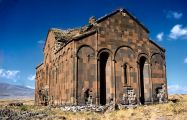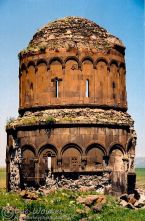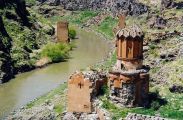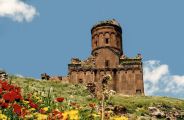On the frontier between Turkey and Armenia, 45 kilometres west of the provincial capital Kars, lies on a great cliff the ghost town of Ani or Hani. At its heyday, one thousand years ago, Ani was the capital of an Armenian Kingdom. It had a population of more than 100,000 people and was the rival of Constantinople, Baghdad, and Cairo. At that time Ani was called The City of 1001 Churches and was renowned for the splendour and magnificence of its buildings.
Historical Background
Ani is first mentioned in Armenian chronicles in the 5th century CE. Located on the crossroad of the trade routes between Byzantium, Persia, Syria, and Central Asia it flourished, and in the 11th century, its population was above 100,000 people. By the end of the 11th century, Ani was subsequently occupied by the Byzantines and Seljuk Turks, who sold it to the Kurdish Shaddadid dynasty. In the year 1200, it was taken again by the Georgian Queen Tamara who gave it to the Mkhargrdzeli family. Under their rule, Ani prospered again and regained much of its former glory. In 1237 it fell to the Mongols who ransacked the city, then Tamerlane rampaged through and mercilessly destroyed what was left. When the trade routes moved further south, the once-bustling metropolis lost its revenue from trade and soon the entire province died. Now, its once crowded streets and marketplaces are empty as the city turned into a ghost town, deserted except for the presence of Turkish soldiers and the occasional tourist.
Sights and Photos of Ani
https://turkeyphotoguide.com/ani?tmpl=component&print=1&layout=default#sigProId51b609cc77
The most prominent and most important building in Ani and a structure of world architectural importance is Ani's Cathedral. According to various historical sources and inscriptions, it is known that building work started in the year 989 under the Armenian King Smbat II (977-89) and was completed, after a halt in construction, by the year 1001 by order of Queen Katranideh the wife of King Gagik Bagratid, Smbat's successor. The cathedral was the work of Trdat, one of the most celebrated architects of medieval Armenia. On the southern facade there is a 21 line inscription which says: In the year 450 (1001 CE) of the Armenians ... at the time of Sarkis, honoured by God and Katholikos, spiritual lord of the Armenians, and during the glorious reign of Gagik, shahanshah of the Armenians and of the Georgians, I Katranideh, Queen of the Armenians, daughter of Vasak, King of Siunik, entrusted myself to the mercy of God and, by order of my husband Gagik shahanshah, built this holy cathedral, which the great Smbat had founded...
The church of The Redeemer is another large church of Ani that was completed around the year 1035. Its walls are covered with long and elegantly carved inscriptions that reveal much of its history. The eastern half of the church collapsed during a storm in 1957. The remainder of the church was badly shaken during the 1989 earthquake and now is in danger of total collapse.
Another religious structure in Ani is the Monastery of the Virgins, a small monastery that stands on a rocky promontory, isolated from the rest of the city and overlooking the Arpa/Akhurian River. The monastery was named after the virgin martyrs of Saint Hripsime, and may have contained a community of nuns.
The church of Saint Gregory of the Abughamir Family is thought to date from the late 10th century and to have been commissioned by Prince Grigor Pahlavuni as a private chapel for the Pahlavuni family. This family rose to great importance during the final years of Ani's independence. The most famous member was Vahram Pahlavuni. Vahram is mentioned in an inscription telling that he set aside money to pay for masses for the soul of his son Abughamir.
The nearby church of Saint Gregory of Tigran Honents was commissioned by a wealthy merchant named Tigran Honents, and completed in the year 1215. On the eastern wall there is an inscription that says:
In the year 664 ( 1215 CE), by the grace of God, when the lord of this city of Ani was the strong and powerful Zakaria ... I, Tigran, servant of God, son of Sulem Smbatorents, of the Honents family, for the long life of my lords and of their children, built this monastery of St. Grigor, which was on the edge of an escarpment and in a place full of underbrush, and I bought it with my legitimate wealth from the owners and with great fatigue and expense, I provided it with defence all around; I built this church in the name of St. Grigor Lusavoritch and I embellished it with many decorations...
When walking through the remains of Ani, the words from the Threnody of the Armenian chronicler Aristakes of Lastivert come into mind:
Where are the thrones of our kings? They are nowhere to be seen. Where are the legions who walked in front of them, in closed rows like a dense thunder cloud, colourful like the flowers in spring and shining in their uniforms? Where is the great and wonderful patriarchal throne? Today it stands empty, robbed from its ruler, deprived of its ornaments, covered by dust and spin rags and the heir of the throne taken to a foreign country as a prisoner. The prayers and songs of the priest have silenced. The candles in the beautiful candle stick have been put out, the lamps dimmed, the sweet smell of incense evaporated, the altar of our Lord is buried under dust and ashes. Now, that all with we fell connected has been taken from us by our sinfulness, now then tell heaven and all who stay there, tell the mountains and the hills and the dense forests, that they too may weep over ending...
Aristekes' work "Regarding the sufferings occasioned by foreign people living around us" sounds even more tragic:
Days of torments came to us, unbelievable troubles found us, because the measure of our sins, having filled up overflowed, and our cry arose before God. Everyone sullied his own road, and the country was filled with impiety. Justice declined, and licentiousness increased. The people and the priest broke their word to God. For this reason, foreign peoples alienated us from our habitation and turned our glory to ruin. No breath remained within us and we became lost through our despair. Death grew strong and swallowed us. Nor did the cemeteries wish to say "Enough!". Everyone attacked us, and in our dying days, there was no time to be healed from the agonies we had already borne.
Travel Information & Travel Tips
I visited Ani in 2003. Procedures and permissions have been subject to change over the years.
Due to the proximity of the Turkish-Armenian border, just as in Soviet days, visitors to Ani must first obtain permission from the tourist office in Kars. The lengthy procedure which is mentioned in many guidebooks has been cut short and there is no need anymore (2003) to pay a visit to the police and the museum in Kars. Permit and entrance ticket are now issued at the Kars tourist office. The employees request the plate number of your car or taxi and try to sell you a packaged tour that they organize. This being the good news.
Due to tensions with Armenia, in 2003 photography was strictly forbidden. When we arrived at Ani, all cameras had to remain in the car. During the visit, after a friendly body search, we were constantly escorted by border guards to ensure that no one went too close to the Turkish-Armenian border. The pictures you find here are scanned-in photographs that I bought at the Kars tourist office.











